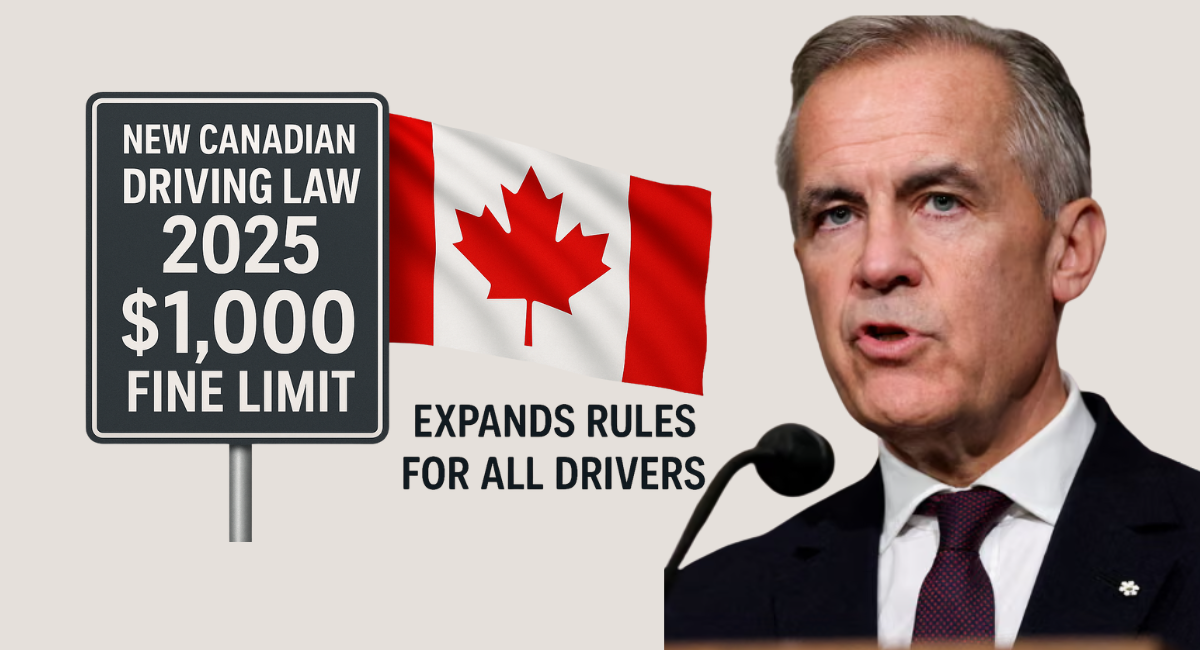Canada is preparing for one of the biggest updates to its road-safety framework in years, as the New Canadian Driving Law 2025 introduces tougher enforcement measures, stronger safety requirements, and expanded rules that apply to every motorist on the road. A major highlight is the implementation of fines that may reach $1,000 for certain violations — a clear sign of Canada’s strengthened stance on distracted driving, speeding, and vehicle compliance.
These changes reflect a nationwide push to improve public safety and reduce collisions, while aligning with modern transportation policy from agencies such as Transport Canada and provincial regulators.
Stricter Penalties for Distracted Driving
One of the most significant shifts in the 2025 law is the heightened penalty for distracted driving, which remains one of the leading causes of preventable collisions across the country. Under the new regulations, motorists caught using handheld devices may face fines of up to $1,000, depending on provincial rules and whether the violation is a first-time or repeat offence.
The focus includes phone use, texting, using smartwatches while driving, and interacting with in-car screens. Provinces such as Ontario and British Columbia have already signaled alignment with the federal framework, meaning stricter penalties will be consistently applied in 2025.
Expanded Rules Apply to All Drivers
Unlike earlier regulations that placed more restrictions on novice drivers, the 2025 law extends several safety requirements to all Canadian drivers, regardless of age or experience level. Key updates include:
- Mandatory compliance with revised seatbelt and child-restraint rules
- Expanded vehicle-inspection requirements
- Tighter enforcement of roadside safety protocols
- More detailed expectations around responsible operation of vehicles with advanced driver-assistance systems (ADAS)
Provincial authorities and the Royal Canadian Mounted Police (RCMP) are expected to play major roles in nationwide enforcement.
Enhanced Safety Measures in High-Risk Zones
The 2025 laws reinforce protections in school zones, construction areas, and densely populated urban regions. These measures include:
- Stricter speed-limit enforcement
- Automated surveillance expansion
- Stronger penalties for failing to yield to pedestrians
- Increased monitoring of commercial vehicles and heavy-duty transport
New technology-based enforcement tools—such as automated speed cameras and enhanced roadside detection—will be more widely deployed by municipalities.
Provincial Variations Still Apply
Although this federal law sets the framework, the exact fines, demerit-point deductions, and licence penalties will remain province-specific. For example:
- Ontario may enforce additional licence suspensions for repeated distracted-driving offences.
- Alberta may add higher demerit penalties for high-speed violations.
- Quebec’s regulations may include newer camera-based ticketing systems.
Drivers are encouraged to review their local provincial rules to understand how the national law impacts them.
How Drivers Can Avoid the $1,000 Fine
To remain compliant under the new driving law, motorists should:
- Keep phones stored while driving
- Use hands-free systems only
- Follow school-zone and residential speed limits
- Ensure all passengers use seatbelts correctly
- Maintain their vehicle and stay updated on inspection requirements
- Avoid multitasking such as eating or grooming while driving
Failing to follow these rules not only risks the $1,000 fine, but may also result in higher insurance premiums, licence suspensions, and long-term driving record consequences.
Conclusion
The New Canadian Driving Law 2025 represents a modernized, stricter approach to road safety, applying tougher penalties and broader safety expectations to all drivers nationwide. With fines climbing as high as $1,000, and stricter enforcement in schools and high-risk areas, Canadians should take proactive steps to adapt. By staying informed, maintaining safe habits, and minimizing distractions, drivers can avoid penalties while contributing to safer Canadian roadways.
FAQs
1. Does the $1,000 fine apply everywhere in Canada?
Penalties vary by province, but many jurisdictions will adopt the federal guideline allowing fines of up to $1,000 for distracted-driving violations.
2. Do these new rules only apply to young or novice drivers?
No. The 2025 updates apply to all drivers, regardless of age or experience.
3. When do the new Canadian driving rules take effect?
Most changes begin rolling out throughout 2025, with some enforcement measures effective early in the year and others phased in mid-2025.


